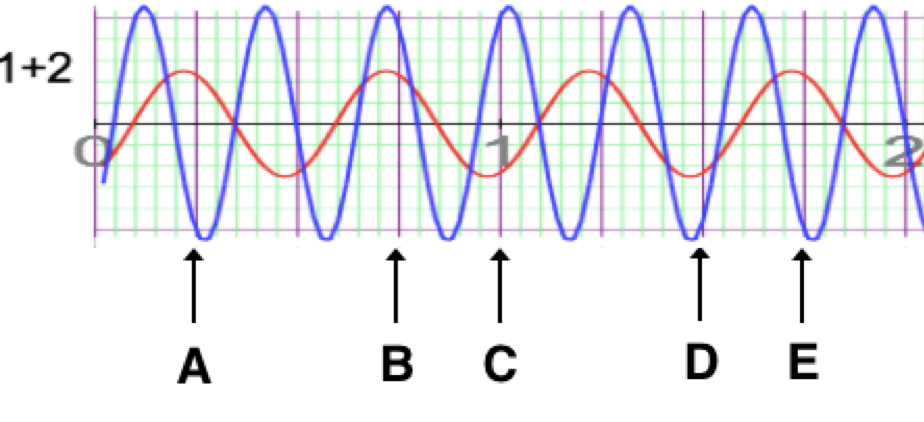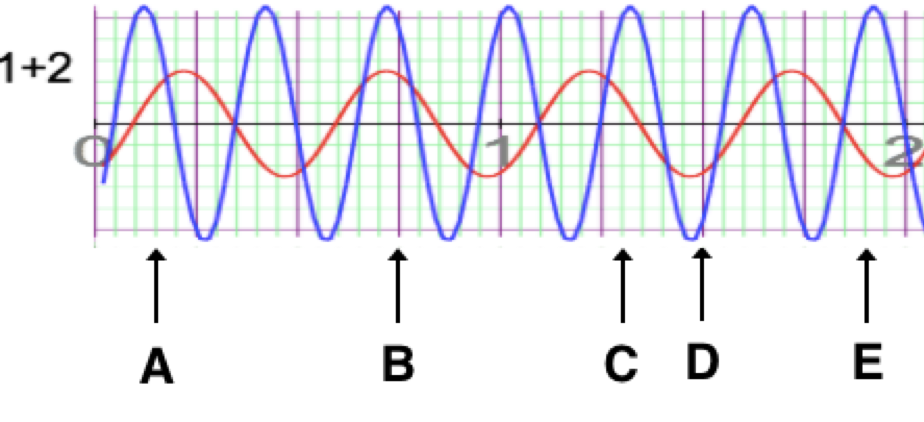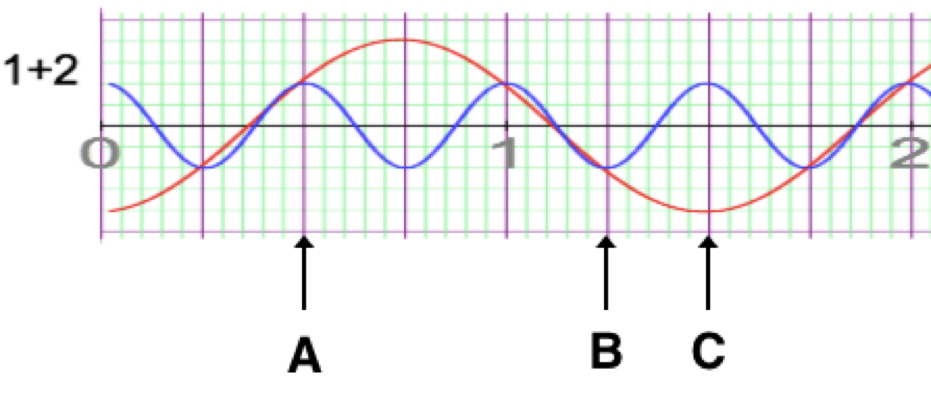Wave Interference Type Questions
The Wave Interference Concept Builder is comprised of 20 questions. The questions are divided into 10 different Question Groups. Questions in the same group are rather similar to one another. The Concept Builder is coded to select at random a question from each group until a student is successful with that group of questions.There are three different activities that can be engaged in through the Concept Builder. Those three activities are described as follows:
- To Construct or To Destruct: Question Groups 1-4. Learners are presented with two interfering waves. They must identify the type of interference at five different locations as being examples of constructive or destructive interference.
- The Principle of Superposition: Question Groups 5-8. Learners are presented with two interfering waves and a background grid. They must use the principle of superposition to determine the displacement of the medium at three specified locations.
- Sum It Up: Question Groups 9-10. Learners are presented with two interfering waves and a background grid. There are nine specified locations along the medium for which learners must identify the location of the medium that would result from the interference of the two given waves.
The questions from each group are shown below. Teachers are encouraged to view the questions in order to judge which activities is/are most appropriate for their classes.
The Physics Classroom grants teachers and other users the right to print these questions for private use. Users are also granted the right to copy the text and modify it for their own use. However, this document should not be uploaded to other servers for distribution to and/or display by others. The Physics Classroom website should remain the only website or server from which the document is distributed or displayed. We also provide a PDF that teachers can use under the same conditions. We have included a link to the PDF near the bottom of this page.
Wave Interference
Activity 1: To Construct or Destruct
Question Group 1
Question 1
Wave 1 (in Red) and Wave 2 (in Blue) are moving through the same medium and undergoing interference. They have different wavelengths, frequencies, and amplitudes. For the five label points, categorise each as being locations where either constructive or destructive interference occurs.
Constructive interference occurs at locations: A B C D E (Circle)
Destructive interference occurs at locations: A B C D E (Circle)
Question 2
Wave 1 (in Red) and Wave 2 (in Blue) are moving through the same medium and undergoing interference. They have different wavelengths, frequencies, and amplitudes. For the five label points, categorise each as being locations where either constructive or destructive interference occurs.
Constructive interference occurs at locations: A B C D E (Circle)
Destructive interference occurs at locations: A B C D E (Circle)
Question Group 2
Question 3
Wave 1 (in Red) and Wave 2 (in Blue) are moving through the same medium and undergoing interference. They have different wavelengths, frequencies, and amplitudes. For the five labeled points, categorize each as being locations where either constructive or descructive interference occurs.
Constructive interference occurs at locations: A B C D E (Circle)
Denstructive interference occurs at locations: A B C D E (Circle)
Question 4
Wave 1 (in Red) and Wave 2 (in Blue) are moving through the same medium and undergoing interference. They have different wavelengths, frequencies, and amplitudes. For the five labeled points, categorize each as being locations where either constructive or descructive interference occurs.
Constructive interference occurs at locations: A B C D E (Circle)
Denstructive interference occurs at locations: A B C D E (Circle)
Question Group 3
Question 5
Wave 1 (in Red) and Wave 2 (in Blue) are moving through the same medium and undergoing interference. They have different wavelengths, frequencies, and amplitudes. For the five labeled points, categorize each as being locations where either constructive or descructive interference occurs.
Constructive interference occurs at locations: A B C D E (Circle)
Denstructive interference occurs at locations: A B C D E (Circle)

Question 6
Wave 1 (in Red) and Wave 2 (in Blue) are moving through the same medium and undergoing interference. They have different wavelengths, frequencies, and amplitudes. For the five labeled points, categorize each as being locations where either constructive or descructive interference occurs.
Constructive interference occurs at locations: A B C D E (Circle)
Denstructive interference occurs at locations: A B C D E (Circle)
Question Group 4
Question 7
Wave 1 (in Red) and Wave 2 (in Blue) are moving through the same medium and undergoing interference. They have different wavelengths, frequencies, and amplitudes. For the five labeled points, categorize each as being locations where either constructive or descructive interference occurs.
Constructive interference occurs at locations: A B C D E (Circle)
Denstructive interference occurs at locations: A B C D E (Circle)

Question 8
Wave 1 (in Red) and Wave 2 (in Blue) are moving through the same medium and undergoing interference. They have different wavelengths, frequencies, and amplitudes. For the five label points, categorise each as being locations where either constructive or destructive interference occurs.
Constructive interference occurs at locations: A B C D E (Circle)
Destructive interference occurs at locations: A B C D E (Circle)

Activity 2: Principle of Superposition
Question Group 5
Question 9
Wave 1 (in Red) and Wave 2 (in Blue) are moving through the same medium and undergoing interference. The displacement of the medium at each location will depend upon the individual displacements of the two waves at that location. For the three labeled locations, determine the nearest estimate of the resulting displacement of the medium. (Each small square is 0.10 m along its edges.)
At location A, the resulting displacement is _______ m.
At location B, the resulting displacement is _______ m.
At location C, the resulting displacement is _______ m.
Question 10
Wave 1 (in Red) and Wave 2 (in Blue) are moving through the same medium and undergoing interference. The displacement of the medium at each location will depend upon the individual displacements of the two waves at that location. For the three labeled locations, determine the nearest estimate of the resulting displacement of the medium. (Each small square is 0.10 m along its edges.)
At location A, the resulting displacement is _______ m.
At location B, the resulting displacement is _______ m.
At location C, the resulting displacement is _______ m.
Question Group 6
Question 11
Wave 1 (in Red) and Wave 2 (in Blue) are moving through the same medium and undergoing interference. The displacement of the medium at each location will depend upon the individual displacements of the two waves at that location. For the three labeled locations, determine the nearest estimate of the resulting displacement of the medium. (Each small square is 0.10 m along its edges.)
At location A, the resulting displacement is _______ m.
At location B, the resulting displacement is _______ m.
At location C, the resulting displacement is _______ m.
Question 12
Wave 1 (in Red) and Wave 2 (in Blue) are moving through the same medium and undergoing interference. The displacement of the medium at each location will depend upon the individual displacements of the two waves at that location. For the three labeled locations, determine the nearest estimate of the resulting displacement of the medium. (Each small square is 0.10 m along its edges.)
At location A, the resulting displacement is _______ m.
At location B, the resulting displacement is _______ m.
At location C, the resulting displacement is _______ m.

Question Group 7
Question 13
Wave 1 (in Red) and Wave 2 (in Blue) are moving through the same medium and undergoing interference. The displacement of the medium at each location will depend upon the individual displacements of the two waves at that location. For the three labeled locations, determine the nearest estimate of the resulting displacement of the medium. (Each small square is 0.10 m along its edges.)
At location A, the resulting displacement is _______ m.
At location B, the resulting displacement is _______ m.
At location C, the resulting displacement is _______ m.
Question 14
Wave 1 (in Red) and Wave 2 (in Blue) are moving through the same medium and undergoing interference. The displacement of the medium at each location will depend upon the individual displacements of the two waves at that location. For the three labeled locations, determine the nearest estimate of the resulting displacement of the medium. (Each small square is 0.10 m along its edges.)
At location A, the resulting displacement is _______ m.
At location B, the resulting displacement is _______ m.
At location C, the resulting displacement is _______ m.
Question Group 8
Question 15
Wave 1 (in Red) and Wave 2 (in Blue) are moving through the same medium and undergoing interference. The displacement of the medium at each location will depend upon the individual displacements of the two waves at that location. For the three labeled locations, determine the nearest estimate of the resulting displacement of the medium. (Each small square is 0.10 m along its edges.)
At location A, the resulting displacement is _______ m.
At location B, the resulting displacement is _______ m.
At location C, the resulting displacement is _______ m.
Question 16
Wave 1 (in Red) and Wave 2 (in Blue) are moving through the same medium and undergoing interference. The displacement of the medium at each location will depend upon the individual displacements of the two waves at that location. For the three labeled locations, determine the nearest estimate of the resulting displacement of the medium. (Each small square is 0.10 m along its edges.)
At location A, the resulting displacement is _______ m.
At location B, the resulting displacement is _______ m.
At location C, the resulting displacement is _______ m.
Activity 3: Sum It Up
Question Group 9
Question 17
Here’s two waves undergoing interference. You have to determine the shape of the resultant wave (or wave sum). To begin, drag each grey dot downward to the height the resultant would have for that horizontal location along the medium.
Question 18
Here’s two waves undergoing interference. You have to determine the shape of the resultant wave (or wave sum). To begin, drag each grey dot downward to the height the resultant would have for that horizontal location along the medium.
Question Group 10
Question 19
Here’s two waves undergoing interference. You have to determine the shape of the resultant wave (or wave sum). To begin, drag each grey dot downward to the height the resultant would have for that horizontal location along the medium.
Question20
Here is two waves undergoing interference. You have to determine the shape of the resultant wave (or wave sum). To begin, drag each grey dot downward to the height the resultant would have for that horizontal location along the medium.






0 Comments
If you have any doubts,please let me know.